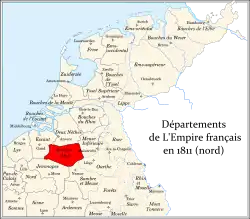Dyle (department)
Dyle ([dil], Dutch: Dijle) was a department of the French First Republic and French First Empire in present-day Belgium. It was named after the river Dyle (Dijle), which flows through the department. Its territory corresponded more or less with that of the Belgian province of Brabant, now divided into Walloon Brabant, Flemish Brabant and the Brussels-Capital Region. It was created on 1 October 1795, when the Austrian Netherlands and the Prince-Bishopric of Liège were officially annexed by the French Republic.[4] Before the annexation, its territory was partly in the Duchy of Brabant, partly in the County of Hainaut, and partly in some smaller territories.
Department of Dyle | |||||||||
|---|---|---|---|---|---|---|---|---|---|
| 1795–1814 | |||||||||
 | |||||||||
 Dyle and other annexed departments | |||||||||
| Status | Department of the French First Republic and the French First Empire | ||||||||
| Chef-lieu | Bruxelles 50°50′N 04°21′E | ||||||||
| Official languages | French | ||||||||
| Common languages | Dutch | ||||||||
| Historical era | French Revolutionary Wars | ||||||||
• Creation | 1 October 1795 | ||||||||
• Treaty of Paris, disestablished | 30 May 1814 | ||||||||
| Population | |||||||||
• 1784[1] | 390,535 | ||||||||
• 1800[2] | 363,661 | ||||||||
• 1806[1] | 432,019 | ||||||||
• 1812[3] | 431,969 | ||||||||
| |||||||||
| Today part of | |||||||||
The Chef-lieu of the department was the City of Brussels (Bruxelles in French). The department was subdivided into the following three arrondissements and cantons (as of 1812):[5]
- Bruxelles: Anderlecht, Asse, Bruxelles (4 cantons), Hal, La Hulpe, Lennik, Woluwe-Saint-Étienne, Uccle, Vilvorde and Wolvertem.
- Louvain: Aerschot, Diest, Glabbeek, Grez-Doiceau, Haecht, Léau, Louvain (2 cantons) and Tirlemont (2 cantons).
- Nivelles: Genappe, Hérinnes, Jodoigne, Nivelles (2 cantons), Perwez and Wavre.
After the defeat of Napoleon the department became part of the United Kingdom of the Netherlands, as the province of (South) Brabant.
Administration
Prefects
The Prefect was the highest state representative in the department.
| Term start | Term end | Office holder |
|---|---|---|
| 2 March 1800[6] | 1 February 1805 | Louis Gustave le Doulcet de Pontécoulant |
| 1 February 1805[7] | 12 May 1808 | François Louis René Mouchard de Chaban |
| 12 May 1808[8] | 12 March 1813 | Frédéric Séraphin de la Tour du Pin Gouvernet |
| 12 March 1813[9] | 30 May 1814 | Frédéric-Christophe d'Houdetot |
General Secretaries
The General Secretary was the deputy to the Prefect.
| Term start | Term end | Office holder |
|---|---|---|
| 26 April 1800[10] | ?? ?? 1806 | Joseph Claude Anne Le Gras de Bercagny |
| ?? ?? 1806 | 30 May 1814 | Jean Jacques Victor Verseyden de Varick |
Subprefects of Bruxelles
The office of Subprefect of Bruxelles was held by the Prefect until 1811.
| Term start | Term end | Office holder |
|---|---|---|
| 14 January 1811[11] | 30 May 1814 | Jean Pierre Henri Amédée Marbotin de Conteneuil |
References
- Massin, Antoine (1812). Almanach du Département de la Dyle (PDF). A.J.D. De Braeckenier. p. 63.
- Oudiette, Charles (1804). Dictionnaire géographique et topographique des treize départements de la Belgique et de la rive gauche du Rhin. Imprimerie de Cramer. p. XIII.
- Almanach Impérial. Imprimerie de Sa Majesté. 1812. p. 396.
- Duvergier, Jean-Baptiste (1835). Collection complète des lois, décrets, ordonnances, réglemens et avis du Conseil d'état, t. 8. p. 300.
- Mémoire statistique du département de la Dyle. Imprimerie de Sa Majesté. 1804.
- Archives Nationales. "LE DOULCET DE PONTÉCOULANT, Louis Gustave". francearchives.fr. Retrieved 21 June 2019.
- Archives Nationales. "MOUCHARD DE CHABAN, François Louis René". francearchives.fr. Retrieved 21 June 2019.
- Archives Nationales. "DE LA TOUR DU PIN GOUVERNET, Frédéric Séraphin". francearchives.fr. Retrieved 21 June 2019.
- Archives Nationales. "HOUDETOT, Frédéric Christophe d'". francearchives.fr. Retrieved 21 June 2019.
- Archives Nationales. "LEGRAS DE BERCAGNY, Joseph Claude Anne". francearchives.fr. Retrieved 21 June 2019.
- Tulard, Jean & Marie-José (2014). Napoléon et 40 millions de sujets: La centralisation et le premier empire. p. 291. ISBN 9791021001480.